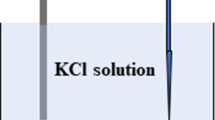Abstract
It has been suggested that distribution of lateral interspace resistance in association with a highly conductive junction can significantly affect the measurement of outer membrane(o)/epithelial(t) voltage divider ratios (F o=δV o/δV t), thereby leading to erroneous inferences regarding the outer membrane fractional resistance [fR o=R o/R c=R o/(R o+R i)], whereR o andR i are the outer and inner cell membrane resistance respectively andR c is the total cell membrane resistance. We present here experimental evidence for this point of view. During seasons when frog skins were highly permeable to Cl, transepithelial conductanceg t often exceeded 2 mS/cm2. High concentrations of external amiloride rapidly blocked cellular transport, butg t initially remained high andF o remained appreciably less than 1.0. These values ofF o were found here to result from low junctional resistanceR j: increase ofR j, either gradually following the administration of amiloride, or abruptly with external replacement of Cl by other anions, was associated with increase ofF o to near unity, without effect on the membrane potential or significant change in the short-circuit current. Experimental results following amiloride validated a simple equivalent circuit model predicting near-linear increase inF o with progressive decrease ing t and led to plausible values ofR j and lateral space resistanceR l. The possible influence of the paracellular resistance pattern on the evaluation of cell membrane resistances from voltage divider ratios is discussed.
Similar content being viewed by others
References
Boulpaep EL (1972) Permeability changes of the proximal tubule of Necturus during saline loading. Am J Physiol 222:517–531
Boulpaep EL, Sackin H (1980) Electrical analysis of intraepithelial barriers. Curr Top Membr Transp 13:169–197
Civan MM, Di Bona DR (1978) Pathways for movement of ions and water across toad urinary bladder. III. Physiologic significance of the paracellular pathway. J Membr Biol 38:359–386
Clausen C, Lewis SA, Diamond JM (1979) Impedance analysis of a tight epithelium using a distributed resistance model. Biophys J 26:291–317
Di Bona DR, Civan MM (1972) Clarification of the intercellular space phenomenon in toad urinary bladder. J Membr Biol 7: 267–274
Essig A (1982) Influence of cellular and paracellular conductance patterns on epithelial transport and metabolism. Biophys J 38:143–152
Finn AL, Bright J (1978) The paracellular pathway in the toad urinary bladder: permselectivity and kinetics of opening. J Membr Biol 44:67–83
Frömter E, Gebler B (1977) Electrical properties of amphibian urinary bladder epithelia. III. The cell membrane resistances and the effect of amiloride. Pflügers Arch 371:99–108
Gordon LGM (1980) Effect of amiloride on conductance of toad urinary bladder. J Membr Biol 52:61–67
Gupta BL, Hall TA, Naftalin RJ (1978) Microprobe measurements of Na, K, and Cl concentration profiles in epithelial cells and intercellular spaces of rabbit ileum. Nature (Lond) 272:70–73
Kristensen P (1983) Exchange diffusion, electrodiffusion and rectification in the chloride transport pathway of frog skin. J Membr Biol 72:141–151
Nagel W (1978) Effects of antidiuretic hormone upon electrical potential and resistance of apical and basolateral membranes of frog skin. J Membr Biol 42:99–122
Nagel W, Garcia-Diaz JF, Essig A (1983) Cellular and paracellular conductance patterns in voltage-clamped frog skin. In: Dinno MA, Callahan AB, Rozell TC (eds) Membrane biophysics II. Physical methods in the study of cellular biophysics. Alan R Liss, New York, pp 221–231
Reuss L, Finn AL (1977) Effects of luminal hyperosmolality on electrical pathways of Necturus gallbladder. Am J Physiol 232:C99–C108
Rick R, Dörge A, Arnim E, Thurau K (1978) Electron microprobe analysis of frog skin epithelium: evidence for a syncytial sodium transport compartment. J Membr Biol 39:313–331
Spring KR, Hope A (1979) Dimensions of cells and lateral intercellular spaces in living Necturus gallbladder. Fed Proc 38:128–133
Thompson SM, Suzuki Y, Schultz SG (1982) The electrophysiology of rabbit descending colon. I. Instantaneous transepithelial current-voltage relations and the current-voltage relations of the Na-entry mechanism. J Membr Biol 66:41–54
Thompson SM, Suzuki Y, Schultz SG (1982) The electrophysiology of rabbit descending colon. II. Current voltage relations of the apical membrane, the basolateral membrane, and the paracellular pathways. J Membr Biol 66:55–61
Ussing HH, Zerahn K (1951) Active transport of sodium as the source of electric current in the short-circuited isolated frog skin. Acta Physiol Scand 23:110–127
Voute CL, Meier W (1978) The mitochondria-rich cell of frog skin as a hormone-sensitive “shunt-path”. J Membrane Biol 40 (Special issue): 151–165
Wills NK, Lewis SA, Eaton DC (1979) Active and passive properties of rabbit descending colon: a microelectrode and nystatin study. J Membr Biol 45:81–108
Author information
Authors and Affiliations
Rights and permissions
About this article
Cite this article
Nagel, W., Garcia-Diaz, J.F. & Essig, A. Contribution of junctional conductance to the cellular voltage-divider ratio in frog skins. Pflugers Arch. 399, 336–341 (1983). https://doi.org/10.1007/BF00652761
Received:
Accepted:
Issue Date:
DOI: https://doi.org/10.1007/BF00652761




